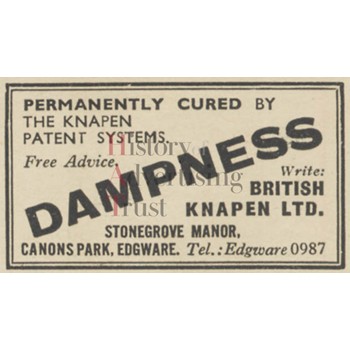In 1919 during the Great War peace conference, a member of the British military delegation noticed something interesting in the  Palace of Versailles: a row of small circular vents along the bottom of a wall. After some inquiries the delegate – one General Brown – found that the vents concealed ceramic tubes set into the wall for damp proofing, a process that had been patented in 1908 by a Belgian, Monsieur Knapen.
Palace of Versailles: a row of small circular vents along the bottom of a wall. After some inquiries the delegate – one General Brown – found that the vents concealed ceramic tubes set into the wall for damp proofing, a process that had been patented in 1908 by a Belgian, Monsieur Knapen.
General Brown introduced the Knapen tubes into Britain under license, and apparently enjoyed some commercial success with British Knapen Ltd before selling up. Ceramic tubes continue to be made, marketed and installed in British homes.
The only trouble with a damp-proofing system which uses ceramic tubes is that it doesn’t work. At first sight, the idea of drilling holes in a wall to remove moisture might seem logical. After all, increasing the exposed surface area should assist evaporation, shouldn’t it? But there was always supposed to be more to the tubes than that. The fine pores of the ceramic clay would actually draw dampness out of brick and stone. The angle at which the tubes were stuck in the wall would cause the moist air to flow away by gravity. It was even thought that the Dutch clay from which the tubes were made had special properties.
But any physicist will tell you that the system cannot work because the finer the pores, the greater the capillary action, or suction – and this makes a material hold on to its moisture, not dry out by evaporation. Any evaporation at the surface of the tubes would cause a build-up of dissolved salts, which would attract moisture from the air and actually make the wall damper. These suspicions were verified by experimental work published in Germany in the 1960s. Ceramic tubes do not make walls dryer, and in some cases they can make them wetter.
Even the PCA©- Property Care Association has a code of good practice which advises against using ceramic tubes.
But nobody in the building game ever let a few facts fog the issue. The contents of foreign-language science journals do not find their way easily into the British press. So decades after they were shown to be worthless, ceramic tubes are still being marketed, and even described in construction textbooks as a proven way of keeping walls dry.
In most instances, ceramic tubes are now aggressively marketed as the ‘Dutch System’ or Holland System’.
Examples can be observed in the brickwork of many UK towns and villages. With variations ranging from small round vented inlets, to unsightly vented bricks.

